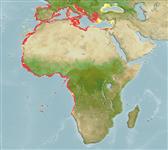Environment: milieu / climate zone / depth range / distribution range
Οικολογία
Θαλασσινό(ά) βενθικό(ς); εύρος βάθους 30 - 400 m (Ref. 5222). Subtropical; 46°N - 18°S, 19°W - 41°E
Eastern Atlantic: Portugal to Angola, including the Mediterranean.
Μέγεθος / Βάρος / Age
Maturity: Lm ? range ? - ? cm
Max length : 164 cm TL αρσενικό/απροσδιόριστο; (Ref. 89707); μεγ. δημοσιευμένο βάρος: 35.0 kg (Ref. 5222)
Ραχιαίες άκανθες (συνολικά): 11; Μαλακές ραχιαίες ακτίνες (συνολικά): 13-14; Εδρικές άκανθες 3; Μαλακές εδρικές ακτίνες: 8. Distinguished by the following characteristics: uniformly dark reddish brown or greyish violet to yellowish grey; posterior parts of median fins with distinct white edge; 2-3 dark bands radiating posteriorly from the eye, uppermost extends from the eye to the lower opercular spine, 2nd runs from the lower edge of the eye across the angle of preopercle to the juncture of interopercle and subopercle, 3rd band extends from the dark mustache streak at the upper edge of the maxilla to the lower edge of preopercle; body depth 2.7-3.0 times in SL; head length 2.3-2.5 in SL; convex interorbital area; angular preopercle, 3-5 distinctly enlarged serrae at the angle and usually slender, antrorse or ventrally directed spine on ventral edge near the angle; serrate subopercle and interopercle; distinctly convex upper edge of operculum; posterior nostril is 2 or 3 times size of anterior nostril; scaly maxilla, reaching to or beyond vertical at rear edge of eye; 2 rows of teeth in midlateral part of lower jaw, inner teeth larger; well developed canines at front of jaws; caudal fin truncate, corners slightly rounded; body scales distinctly ctenoid, with numerous auxiliary scales (Ref. 089707).
Occurs on sandy mud bottoms (Ref. 3589). Feeds on fishes and invertebrates (Ref. 5506). Maximum weight of 78 kilograms reported by Jose Manuel, Spain (05/05).
Life cycle and mating behavior
Γεννητική Ωρίμανση | Αναπαραγωγή | Γεννοβολία | Αβγά | Γονιμότητα | Προνύμφες
Heemstra, P.C. and J.E. Randall, 1993. FAO Species Catalogue. Vol. 16. Groupers of the world (family Serranidae, subfamily Epinephelinae). An annotated and illustrated catalogue of the grouper, rockcod, hind, coral grouper and lyretail species known to date. Rome: FAO. FAO Fish. Synop. 125(16):382 p. (Ref. 5222)
IUCN Red List Status (Ref. 130435)
Threat to humans
Harmless
Human uses
αλιεία: Εμπορικό(ά)
Περισσότερες πληροφορίες
Κοινά ονόματαΣυνώνυμαΜεταβολισμόςΘηρευτέςΟικοτοξικολογίαΑναπαραγωγήΓεννητική ΩρίμανσηΓεννοβολίαΣυναθροίσεις γεννοβολίαςΓονιμότηταΑβγάEgg development
ΑναφορέςΥδατοκαλλιέργειεςΠροφίλ υδατοκαλλιέργειαςΣτελέχοιΓενετικήElectrophoresesΚληρονομικότηταΑσθένειεςΜεταποίησηNutrientsMass conversion
ΣυνεργάτεςΦωτογραφίεςStamps, Coins Misc.ΉχοιΣιγκουατέραΤαχύτηταΚολυμβητικός ΤύποςΕπιφάνεια βραγχίωνOtolithsΕγκέφαλοιΌραση
Εργαλεία
Special reports
Download XML
Διαδικτυακές πηγές
Estimates based on models
Preferred temperature (Ref.
123201): 12.3 - 17.2, mean 14.9 °C (based on 180 cells).
Phylogenetic diversity index (Ref.
82804): PD
50 = 0.5000 [Uniqueness, from 0.5 = low to 2.0 = high].
Bayesian length-weight: a=0.01175 (0.00571 - 0.02419), b=3.04 (2.88 - 3.20), in cm total length, based on LWR estimates for this Genus-body shape (Ref.
93245).
Τροφικό Επίπεδο (Ref.
69278): 3.8 ±0.55 se; based on food items.
Generation time: 28.2 ( na - na) years. Estimated as median ln(3)/K based on 1
growth studies.
Ελαστικότητα (Ref.
120179): Πολύ χαμηλό, ελάχιστος χρόνος για διπλασιασμό πληθυσμού > 14 έτη (Preliminary K or Fecundity.).
Fishing Vulnerability (Ref.
59153): Very high vulnerability (87 of 100).
Nutrients (Ref.
124155): Calcium = 22.5 [8.2, 54.4] mg/100g; Iron = 0.669 [0.308, 1.587] mg/100g; Protein = 18.2 [16.5, 19.9] %; Omega3 = 0.267 [0.136, 0.540] g/100g; Selenium = 52.6 [20.4, 126.8] μg/100g; VitaminA = 19.2 [4.0, 96.1] μg/100g; Zinc = 0.745 [0.455, 1.220] mg/100g (wet weight);
